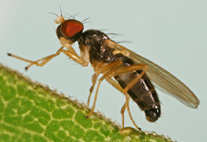Abstract
World representatives of the genus Arganthomyza Roháček, 2009 (Diptera, Anthomyzidae) are reviewed, keyed and their relationships are discussed on the basis of a phylogenetic analysis of morphological characters. The Nearctic species of Arganthomyza are revised, described and illustrated, and first data about their biology and distribution are given. Five new species, A. carbo sp. n. (Canada, USA), A. acuticuspis sp. n. (USA), A. bivittata sp. n. (Canada, USA), A. duplex sp. n. (Canada, USA) and A. disjuncta sp. n. (Canada, USA) are described and A. socculata (Zetterstedt, 1847) is newly recorded from the Nearctic Region (USA: Alaska). Based on the phylogenetic analysis, four main clades/species groups are recognized within Arganthomyza, represented by the following species: A. barbarista Roháček, 2009 (A. barbarista group); A. setiplanta (Roháček, 1987), A. versitheca Roháček, 2009 and A. carbo sp. n. (A. setiplanta group); A. acuticuspis sp. n., A. bivittata sp. n. and A. duplex sp. n. (A. duplex group); A. disjuncta sp. n. and A. socculata (Zetterstedt) (A. socculata group). Considering the contemporary distribution and relationships of Arganthomyza species, it is hypothesized that the A. barbarista group and A. setiplanta group originated in East Asia while the A. duplex group and the A. socculata group each has its origin in the Nearctic Region.
References
Andersson, H. (1976) Revision of the Anthomyza species of Northwest Europe (Diptera: Anthomyzidae) I. The gracilis group. Entomologica Scandinavica, 7, 41–52. http://dx.doi.org/10.1163/187631276X00072
Andersson, H. (1984) Family Anthomyzidae. In Soós, Á. & Papp, L. (eds.): Catalogue of Palaearctic Diptera. Vol. 10, Akadémiai Kiadó, Budapest, pp. 50–53.
Collin, J.E. (1944) The British species of Anthomyzidae (Diptera). The Entomologist’s Monthly Magazine, 80, 265–272.
Czerny, L. (1902) Bemerkungen zu den Arten der Gattungen Anthomyza Fll. und Ischnomyia Lw. Wiener Entomologische Zeitung, 21, 249–256.
Czerny, L. (1928) 54b. Anthomyzidae. In Lindner, E. (ed.): Die Fliegen der palaearktischen Region. Vol.6, pt.1, E. Schweizerbartsche Verlagsbuchhandlung, Stuttgart, 8 pp.
Goloboff, P. (1999) NONA (NO NAME) ver. 2.0. Published by author, Tucumán, Argentina.
Krogerus, R. (1960) Ökologische Studien über nordische Moorarthropoden. Societas Scientiarum Fennica. Commentationes Biologicae, 21(3), 1–238.
Loew, H. (1873) Systematische Beschreibung der bekannten europäischen zweiflügeligen Insekten. Von Johann Wilhelm Meigen. 10. Theil oder 4. Supplementband. Beschreibung europäischer Dipteren 3, Verlag von H. W. Schmidt, Halle, viii + 320 pp.
Nixon, K.C. (2002) WinClada ver. 1.00.08. Published by author, Ithaca, NY.
Roháček, J. (1984) New species and records of Palaearctic species of the Anthomyza gracilis-group (Diptera, Anthomyzidae). Acta Entomologica Bohemoslovaca, 81, 384–394.
Roháček, J. (1987) Two new species of the Anthomyza gracilis-group (Diptera, Anthomyzidae) from Nepal. Acta Entomologica Bohemoslovaca, 84, 48–59.
Roháček, J. (1998) Taxonomic limits, phylogeny and higher classification of Anthomyzidae (Diptera), with special regard to fossil record. European Journal of Entomology, 95, 141–177.
Roháček, J. (1999) A revision and re-classification of the genus Paranthomyza Czerny, with description of a new genus of Anthomyzidae. Studia dipterologica, 6, 373–404.
Roháček, J. (2006) A monograph of Palaearctic Anthomyzidae (Diptera) Part 1. Časopis Slezského zemského muzea, Opava (A), 55, suppl. 1, 1–328.
Roháček, J. (2009) A monograph of Palaearctic Anthomyzidae (Diptera) Part 2. Časopis Slezského zemského muzea, Opava (A), 58, suppl. 1, 1–180.
Roháček, J. & Barber K.N. (2011) Quametopia, a new genus of Nearctic Anthomyzidae (Diptera), with description of two new species, immature stages and life history. European Journal of Entomology, 108, 287–326.
Roháček, J., Tóthová, A. & Vaňhara, J. (2009) Phylogeny and affiliation of European Anthomyzidae (Diptera) based on mitochondrial 12S and 16S rRNA. Zootaxa, 2054, 49–58.
Soós, Á. (1981) 58. család: Anthomyzidae—Tüskéscombú legyek. Fauna Hungariae 149, Akadémiai Kiadó, Budapest, pp. 106–117.
Stackelberg, A.A. (1970) 83. sem. Anthomyzidae. In Bei‑Bienko, G. Ya. (ed.): Opredelitel nasekomykh evropeiskoi chasti SSSR. Vol. 5, pt. 2, Nauka, Leningrad, pp. 326–329 (in Russian).
Trojan, P. (1962). Zeszyt 54–58 Odiniidae, Clusiidae, Anthomyzidae, Opomyzidae, Tethinidae. Klucze do oznaczania owadów Polski. Część XXVIII Muchówki—Diptera. Państwowe Wydawnictwo Naukove, Warszawa, 68 pp. (in Polish).
Zatwarnicki, T. (1996) A new reconstruction of the origin of eremoneuran hypopygium and its implications for classification (Insecta: Diptera). Genus, 7(1), 103–175.
Zetterstedt, J.W. (1847) Diptera Scandinaviae. Disposita et descripta. Vol. 6, Officina Lund-bergiana, Lundae [= Lund], pp. 2163–2580.

